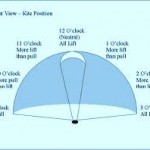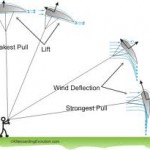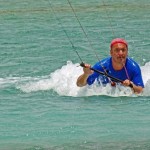So the second day of my journey to achieve nirvana on the waves, was as big a learning curve as Day 1. The view from the heights of Kula looking down toward the north shore of Maui’s isthmus was spectacular. Acres of green sugar cane underlined blue sky, blue ocean and a white band of waves off the beaches. I wouldn’t be riding those waves quite yet! After crashing the trainer kite many more times, and finally getting it to fly at twelve o’clock, I was on my way. My instructor was still holding the handle on the back of my harness so I wouldn’t take off with every gust, but generally I was progressing in the right direction. Instant gratification however, is not in the title of this Blog!
The next step to Mastery is flying a real kite. There are many different kite designs, but the basics are a “C” kite, “Bow” kite and a “Ram Air” kite. The last is usually only used on land (like snow or dessert kiting) because it needs the wind to blow up the open-ended tubes. Once dropped in the water, even thought it’s beautifully warm in Maui, it’s a long swim to shore! The other two have internal rubber air bladders which give them shape. The leading edge, facing the wind, is filled with air, as are 3 to 5 struts extending back to hold the fabric out.
Wind consistency is the most important part of this equation. Too much and I start intersecting with the out-going flights at Kahului Airport. Too little and the thing drops on my head! My ever-patient instructor spends hours launching and holding me down as I figure out the dynamics of the “wind window”.
Too high over head and it loses lift, too low and I hit the power zone – not good on terra firma as I launch and nose-dive in the sand! I sported an impressive omelet-sized bruise on my leg after one-such trajectory through space. Time to get in the water.
The body drag is pretty much as it sounds. Being dragged uncontrollably through the water on the end of four tiny strings attached to a wild bronco. One second
I’m trying to stop the kite diving for the water – sheet out! Sheet out! The next second I’m waving the kite through the power zone and being catapulted out of the water only to be unceremoniously dunked. Water up my nose, hair in my eyes, totally ungraceful, but still hanging on by God! Normally the ego would be severely bruised at this point, floundering around in full view of all the experts zipping around me, niftily tacking to avoid my downed kite, but I’m too busy clearing my sinuses and trying not to drown. No problem! I can handle it – really!
At least at this point I’m less likely to damage the kite or myself, so confidence grows. I’m still hooked, but have come to the understanding that this is a skilled sport, and a weekend warrior like myself needs more consistent practice. It’s not like putting a mask and fins on and instantly seeing fish. My office is 5 minutes from Kanaha Beach so I’m off to the beach after work to get more sea-time in! Stay tuned for more…Self Rescue and understanding the Power Stroke.
On a more serious note. Kite boarding is a dangerous sport. You must never try this without an instructor. There are Rules and Safety protocol to follow. Learning how to de-power, get rid of or cut away from your kite in an emergency is crucial. The very-thin lines can tangle around limbs and if the kite suddenly fills, can cause severe injury and even death.
Follow me on Twitter – @MarinaOnMaui, and Facebook – Marina Batham, Realtor Broker
www.MarinaOnMaui.com



 Welcome to Our Blog Page
Welcome to Our Blog Page





